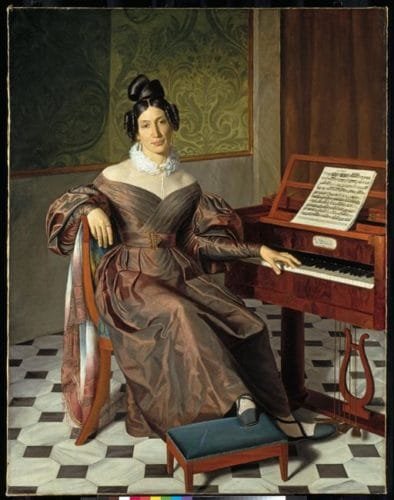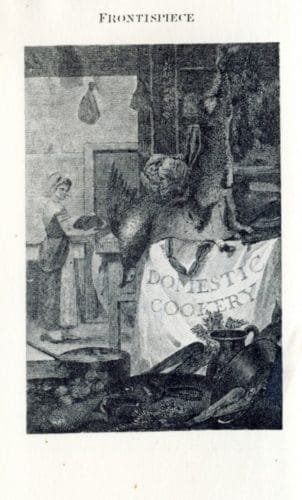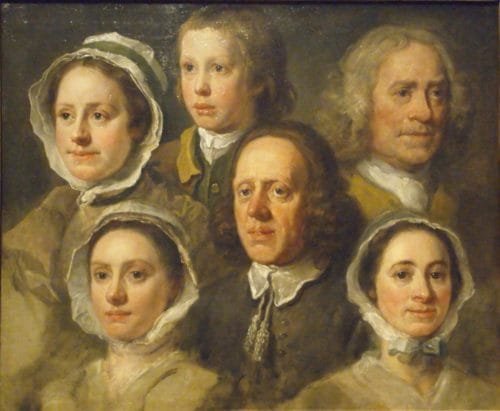Mistress of the manor: Lady of leisure or Full time working mom?
What did Jane Austen’s ladies do all day? Were they ladies of leisure or full time working women?
Period dramas have left many of us with the notion that ladies of the landed gentry in the Regency era had little to do but dress in lovely gowns, embroider and gossip. Reality could not be farther from this image.
In general, both master and mistress of the manor did a great deal of work around the estate, often working alongside the servants in the efforts to get everything done. Labor tended to be divided along gender lines. So much so that single men sought female relatives to manage their households. Bachelors looked to sister or nieces while widowers often called upon daughters or the dead wife’s kin. So, even if a woman did not marry, there was a very strong possibility she might take on the responsibilities of a household sometime in her lifetime.
Gentlemen tended to respect the household mistress’ authority; her contributions to the home had worth equal to his. Considering the big picture, this made a great deal of sense. A living space was not really considered a home unless there was a woman in charge of it.
Responsibilities of the Mistress of the Manor
The role of an estate’s mistress was the equivalent of, depending on the size of the estate, managing a small hotel to being the CEO of a major corporation. She oversaw the finances, food service, hiring and training of the staff, procurement, charitable contributions of the ‘company’ as well as the interior design of the ‘corporate headquarters’ and entertaining. Depending on her intelligence, she might also assist her husband with overall estate business. While accomplishing all this, she was also expected to raise her children and cared for sick family members. Talk about a working mother.
Children

The mistress’ responsibilities to her children are perhaps the most obvious. First, she was expected to provide them in the first place. A man expected to have an heir to whom he could pass the estate.
Once children were born, it was on her shoulders to hire the nursery maids and governess, if the estate could afford them. If not, she would care for them herself. She was responsible for their education, whether she conducted it herself or hired others to teach them.
Once boys reached the age of seven or eight, they would be sent off to be educated, either as day students to a local school master or to boarding school. As her daughters grew older, it was their mother’s role to ensure they acquired the expected accomplishments for their station in order to see them well married–essentially the only option to secure the future of a respectable young lady.
A young woman’s accomplishments were a primary way for her to attract attention from potential marriage partners. The degree of a woman’s accomplishments reflected both her family’s wealth and their commitment to having her marry well. The mistress of the house would tutor them in the skills she could and arrange for masters to be brought in to teach the rest, if the family finances allowed. Girls might also spend time away at school to attain some of these accomplishments
Necessary female accomplishments included singing, playing an instrument, dancing, speaking French and possibly Italian, drawing and painting, sewing and decorative needlework, elegant penmanship, and the ability to conduct polite conversation that revealed suitable knowledge of history, literature and poetry. Reading aloud in a pleasing manner might also be considered as part of this list, although not nearly as significant as the others. Interestingly enough, sufficient understanding of mathematics to manage household ledgers was also required.

Dancing, singing and playing music were particularly valuable accomplishments because they displayed the young woman’s body and bearing to potential suitors. The harp was considered as the most distinguished instrument, but most girls had to settle for the piano.
No well-bred lady would ever play a wind instrument as blowing into something might result in a red face or heaving bosom, neither of which would be particularly attractive. Similarly, the violin was not an appropriate instrument for a lady because raising the arms to play it in a short bodied dress was an invitation to disaster. Moreover, while one could fudge and slur their way through a piano piece, the violin was not an instrument for amateurs.
Financial Management
Managing the household budget and accounts made up a large part of the mistress’ efforts. Numerous domestic manuals, including Mrs. Rundell’s, “A New System of Domestic Cookery”, were available to assist women in the process. Mrs. Rundell warned ‘the welfare and good management of the house’ depended on their careful surveillance. Accounts should be regularly kept and ‘not the smallest article’ omitted. That included weighing meat, sugar and similar commodities when they came from the retailer and comparing them with the charge. So, the mistress also served as the CFO of her domestic organization, carefully managing the budget and the household’s use of credit.

She might earn some additional money from managing the dairy and poultry, which was almost exclusively a female domain. Selling eggs, milk and surplus fowl could bring a tidy sum into the household, if carefully managed. Of course, doing so also meant more that required her attention.
Supplying the Manor
All manner of supplies for the home were handled by the mistress. What could not be made in house was purchased. What could be made was.
Planning for and managing the creation of necessary products could be a huge year-round endeavor. Most ladies had books of ‘reciepts’ and instructions into which they added their newest receipts to those of their foremothers. All manner of foodstuffs and herbs were raised and preserved using recipes and instructions in their receipt books. To neglect this process was to risk the family go without during the winter when it was often difficult to purchase supplies.
Beyond this, the mistress of an estate oversaw the making, mending and cleaning of the family’s clothes. Clothing for the servants might also be included in her purview. Soap for laundry and household use required animal fat and wood ashes to be saved and stored until needed. Water from boiling rice and potatoes was saved for starching clothes. Animal and even human urine (yikes!) was also saved for wash day.
Various medicinal preparations would also be crafted and kept on hand in case of need.
Servants

Although men were legally responsible for hiring and firing servants, the mistress oversaw the engaging, instructing and supervising of domestic servants. Close control and supervision could be necessary. Many records of the era note inefficient and dishonest servants were common place. Furthermore, servants were often only seeking short term situations, so the high turnover rate required the mistress to be constantly on the lookout for recommendations for new potential servants.
Not only did the mistress manage the servants, she was also in a position to care for their needs. She typically kept herself informed about their families, illnesses and needs and provided for their care including clothing, medical care, possible education, and occasionally leave in emergency situations.
Community
The responsibilities of a landowner’s wife extend beyond the home into the community at large, both to those who were her social equals and to those below her in social rank. To those on her level, she would be expected to host dinners and social gatherings, providing entertainment and social connections for her sphere. Regular calls would be paid normal among her social circle.
To her social inferiors, she owed another kind of duty. In rural areas where no doctor was available, she might be called upon for her advice in treating the sick and injured. The village children needed to be educated—she was the one to organize the dame school to teach them to read and write. At Christmas time, she would provide gifts of baby clothes, blankets, shawls, coats, stockings and flannel petticoats to the villagers.
The mistress of the estate also was expected to care for the poor. She might meet with the local clergy man to find out their needs and determine how to meet them. It was her role to visit them, deliver food-often in the form of leftovers from her own table, give advice, and listen to their complaints. Since the indigent had no other support system the gracious provision of the estate’s mistress provided a needed safety net.
So much for covering screens and eating biscuits. The Regency estate’s mistress was no lady of leisure; she was a full time working mother, business partner to her husband, and ideally, a leader in her community.
References
Davidoff, Leonore & Hall, Catherine. Family Fortunes: Men and Women of the English Middle Class 1780-1850. Routledge (2002)
Horn, Pamela. Flunkeys and Scullions, Life Below Stairs in Georgian England . Sutton Publishing (2004)
Le Faye, Deirdre. Jane Austen: The World of Her Novels. Harry N. Abrams (2002)
Rundell , Maria Eliza Ketelby. New System of Domestic Cookery: Founded up Principles of Economy; and Adapted to the Use of Private Families. (1806)
Sullivan, Margaret C. The Jane Austen Handbook .Quirk Books (2007)
Vickery, Amanda. The Gentleman’s Daughter. Yale University Press (1998)
by Maria Grace © 2013, all rights reserved


What a fantastic article! I always knew there was more to managing a household than met the eye, but I didn’t realize there was so much to do! Sharing on my blog 😀
Lovely post. It is so nice to see a less than superficial account of how the mistress of the manor spent her time.
Amazing and informative. I will read my regency novels with a whole new respect for these ladies of leisure.
Thank you for all the research
Oh great information!!!
Succinct, compelling and well researched. Great work. Have you come across any cases where especially skilled or efficient staff were pooled between neighboring estates to alleviate finding good help?
Pingback:Mistress of the Manor: Lady of Leisure or Full Time Working Mom? | And Then He Kissed Her
Thank you! I recently did a blog something like this, but was limited as to my word count. I’m doing another one later. Interestingly, about the time the blog went up, someone reviews my second book and said she had trouble believing that my heroine, 21 years old, who’d been running the house for a couple of years could have so many domestic accomplishments at such a young age. Bosh.
Tweeted and shared on FB.
I absolutely loved it. Wow, what a lot of work. …..for you and the mistress of the house.
Pingback:An Accomplished Young Lady |
Pingback:To be an Accomplished Lady - Random Bits of Fascination
Pingback:To be an Accomplished Lady | Random Bits of Fascination
Magnificent read